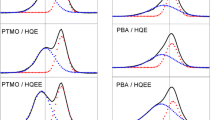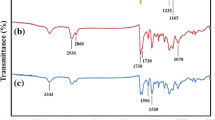Abstract
A series of segmented polyurethanes containing 60 wt° of hard segments (HS) was prepared from MDI (4,4′-diphenylmethane diisocyanate) ethylene glycol and mixtures of a polyoxyethylene end-capped polyoxypropylene triol and a polyoxyethylene end-capped polyoxypropylene diol. The effects of the content of polyether diol in polyether polyols on phase separation and properties was investigated by dynamic mechanical analysis (DMA), differential scanning calorimetry (DSC) and investigation of tensile properties. The DSC and DMA results indicate that the polyurethane derived from only polyether triol exhibits obvious phase separation and that the HS is immiscible with the SS, but that the HS is compatible with the HS for the polyurethane derived from polyether diol. As the content of polyether diol increases, the compatibility between HS and SS increases. As the content of polyether diol increases, the tensile strength. elongation. toughness and tear resistance of the polyurethanes increases. but their moduli decrease. The modulus-temperature dependence in the temperature region of −30 to 65 °C increases as the polyether diol content increases.
Similar content being viewed by others
References
N. Barksby. D. Dunn. A. Kaye, J. L. Stanford and R. F. T. Stepto,Reaction Injection Moulding, Ed. J. E. Kresta, ACS. 1985. p. 83.
G. Oertel.Polyurethane Handbook, Hauser Publishers, New York, 1985.
D. K. Lee, H. B. Tsai and J. L. Stanford,J. Polym. Res.,3, 159 (1996).
J. W. C. Van Bogart. A. Lilanonitkul and S. L. Cooper,Multiphase Polymers, S. L. Cooper, Ed., ACS, New York, 1979, p. l.
R. J. Zdrahala. S. L. Hager, R. M. Gerkin and F. E. Critchfield,J. Elast. Plast.,12, 225 (1980).
A. J. Ryan, C. W. Macosko and W. Bras,Macromolecules,25, 6277 (1992).
R. M. Brider and E. L. Thomas,J. Macromol. Sci. Phys.,B22, 553 (1983).
W. R. Sorenson and T. W. Campbell,Preparative Methods of Polymer Chemistry, Interscience Publishers, New York, 1961.
J. M. G. Cowie,Polymers: Chemistry and Physics of Modern Materials, Intertext Book, London, 1973.
D. I. David and H. B. Staley,Analytical Chemistry of Pol yurethanes, Vol. XVI, Part 3, Wiley-Interscience, New York, 1965.
A. J. Kinloch and R. J. Young,Fracture Behaviour of Polymers, Applied Science, London, 1983.
Author information
Authors and Affiliations
Rights and permissions
About this article
Cite this article
Lee, DK., Tsai, HB. & Stanford, J.L. Phase separation in segmented polyurethanes derived from mixtures of polyether polyols with different functionality. J Polym Res 3, 221–225 (1996). https://doi.org/10.1007/BF01493491
Issue Date:
DOI: https://doi.org/10.1007/BF01493491




